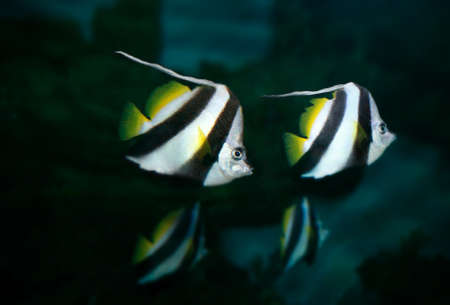Introduction to UK Aquarium Fishkeeping
Fishkeeping remains one of the most beloved hobbies in the UK, attracting enthusiasts of all ages who are drawn to both the tranquillity and the vibrant beauty that aquariums bring into their homes. While marine aquariums offer a stunning array of exotic species, freshwater tanks continue to dominate British households due to their accessibility, affordability, and lower maintenance requirements. Culturally, keeping fish is seen as not only a relaxing pastime but also an educational opportunity for families and children, promoting an appreciation for aquatic life and environmental stewardship. Environmental considerations are also at the forefront for many UK aquarists; with growing awareness about sustainability, there is a preference for species that can thrive in local water conditions and do not contribute to the depletion of wild populations. The popularity of freshwater aquariums has grown alongside increased access to responsibly bred fish and advanced aquarium technology, making it easier than ever for hobbyists to create healthy ecosystems at home.
2. Top 10 Freshwater Fish Species for UK Aquarists
For aquarists in the UK, freshwater fishkeeping offers a diverse and accessible entry into the world of aquatics. Below is a curated list of the top 10 freshwater species that are not only popular among UK hobbyists but also known for their adaptability, vibrant appearance, and manageable care requirements. Each species brings its own charm to home aquariums, and understanding their unique needs ensures a healthy and thriving tank environment.
| Species | Appearance & Behaviour | Tank Requirements | Care Level |
|---|---|---|---|
| Neon Tetra (Paracheirodon innesi) | Small, bright blue and red stripes; peaceful schooling fish | Min. 40L, soft acidic water, planted tank preferred | Easy |
| Guppy (Poecilia reticulata) | Colourful tails; active and hardy livebearers | Min. 30L, adaptable to various water conditions | Very Easy |
| Zebra Danio (Danio rerio) | Zebra-like stripes; lively and resilient community fish | Min. 40L, prefers cooler temperatures (18–24°C) | Very Easy |
| Corydoras Catfish (Corydoras spp.) | Bottom dwellers; social, gentle scavengers | Min. 50L, soft substrate to protect barbels | Easy |
| Siamese Fighting Fish (Betta splendens) | Striking colours; males are territorial and best kept singly | Min. 20L, warm water (24–28°C), low flow | Moderate |
| Dwarf Gourami (Trichogaster lalius) | Iridescent hues; peaceful, good for planted tanks | Min. 60L, gentle filtration, dense planting preferred | Moderate |
| Bristlenose Pleco (Ancistrus spp.) | Suckermouth with bristles; algae eater, nocturnal habits | Min. 80L, driftwood, hiding spots essential | Easy-Moderate |
| Mollies (Poecilia sphenops) | Diverse shapes/colours; lively livebearers, tolerant of salt addition | Min. 60L, hard alkaline water preferred | Easy-Moderate |
| Cherry Barb (Puntius titteya) | Males turn bright red; peaceful schooling fish ideal for community tanks | Min. 50L, well-planted tanks preferred | Easy |
| Amano Shrimp (Caridina multidentata) | Larger shrimp; efficient algae eaters and tank cleaners | Min. 40L, stable parameters, secure lid needed | Easy-Moderate |
Main Features of Popular Freshwater Fish in the UK Aquarium Hobby:
- Diversity: These species offer a variety of sizes, colours, and behaviours suitable for both beginners and experienced keepers.
- Cohabitation: Many of these fish thrive in mixed-species community tanks when provided with compatible tank mates and adequate space.
- Sustainability: Most are readily available through responsible breeders or local aquatic shops across the UK.
Caring for Your Freshwater Favourites: Key Considerations for UK Aquarists
- Tropical Heating: Most freshwater species require a reliable heater to maintain stable temperatures year-round due to the UKs cooler climate.
- Water Quality: Regular testing for ammonia, nitrites, nitrates, pH, and hardness is essential for long-term health.
- Aquascaping: Natural décor like plants and wood helps mimic native habitats and reduces stress in your aquatic residents.
The Takeaway for UK Freshwater Fish Enthusiasts:
Selecting the right combination of species tailored to your experience level and tank setup not only makes maintenance easier but also enhances the visual appeal and ecological balance of your aquarium. The above list provides an excellent starting point for anyone considering a freshwater setup in the UK.

3. Benefits and Challenges of Freshwater Aquariums
Freshwater aquariums are particularly popular among UK aquarists, but how do they really stack up against their marine counterparts? Below, we explore the key benefits and challenges, looking at important factors such as cost, maintenance requirements, accessibility for beginners, and ecological impact.
| Aspect | Freshwater Aquariums | Marine Aquariums |
|---|---|---|
| Initial Cost | Generally lower; basic setups can be affordable for most hobbyists. | Significantly higher due to specialised equipment and salt mixes. |
| Maintenance | Easier routine care; water changes and cleaning are straightforward. | Requires close monitoring of salinity, pH, and trace elements; more time-consuming. |
| Accessibility | Wide range of fish and plants available at local UK shops; ideal for beginners. | Limited species availability; often need to order online or from specialist suppliers. |
| Ecological Impact | Mainly bred in captivity; lower risk to wild populations. | Some species still wild-caught, raising concerns about reef ecosystems. |
Cost Considerations for UK Hobbyists
Freshwater tanks typically appeal to those on a budget or just starting out. From the initial purchase of equipment to ongoing care, the expenses are more manageable compared to marine tanks. This accessibility helps foster a thriving community across the UK’s towns and cities.
Maintenance Differences: Simplicity vs. Complexity
The simplicity of maintaining a freshwater aquarium is a key attraction. Standard tap water (with proper treatment) is usually sufficient, while marine systems require precise mixing of salts and minerals—an added challenge for newcomers. Equipment such as protein skimmers or high-output lighting is also less commonly needed in freshwater setups.
Sustainability and Ecological Responsibility
An increasing number of British aquarists are mindful of their environmental footprint. Since most freshwater species are captive-bred within Europe, there’s less strain on natural ecosystems compared with marine varieties where wild collection may still occur. Choosing local sources not only supports sustainable practices but also reduces transport emissions.
Summary Table: Freshwater vs Marine Aquariums at a Glance
| Freshwater | Marine | |
|---|---|---|
| Start-up Cost | £50-£200 | £300+ |
| Monthly Maintenance Cost | £10-£20 | £30-£60 |
| Main Suitability | Beginners & Families | Experienced Hobbyists |
For those living in the UK, freshwater aquariums offer an accessible, cost-effective, and environmentally conscious way to enjoy the beauty of aquatic life compared to marine alternatives, making them an excellent choice for both new and seasoned enthusiasts alike.
4. How Freshwater Species Compare to Marine Varieties
When choosing between freshwater and marine fish for your UK aquarium, its important to consider the distinct behavioural, aesthetic, and care requirements each group presents. Many aquarists are drawn to the unique challenges and rewards offered by both types, yet their differences can significantly influence your enjoyment and success as a hobbyist.
Behavioural Differences
Freshwater fish such as Guppies, Neon Tetras, and Corydoras tend to exhibit peaceful schooling behaviours, making them ideal for community tanks. In contrast, many popular marine species like Clownfish or Damselfish may display territorial tendencies or require more space to thrive. Additionally, marine fish often showcase complex symbiotic relationships – think of the classic partnership between Clownfish and sea anemones – which is less commonly seen in freshwater setups.
Aesthetic Appeal
The visual allure of marine species is often cited as a major attraction; their vivid colours and intricate patterns, such as those seen in Royal Grammas or Butterflyfish, can be breathtaking. However, advancements in selective breeding mean that freshwater varieties now offer remarkable diversity too, with striking options like Betta splendens and Discus available in UK aquatics shops. The table below summarises key aesthetic differences:
| Aspect | Freshwater Fish | Marine Fish |
|---|---|---|
| Colour Range | Diverse but typically softer hues | Extremely vibrant and varied |
| Body Shapes | Wide range from streamlined to round-bodied | Often more elaborate and angular shapes |
| Habitat Decor | Plants, wood, rocks (naturalistic) | Corals, live rock (reef-like) |
Care Requirements
Freshwater aquariums are generally easier and less costly to set up and maintain – tap water treated with dechlorinator usually suffices for most species. In contrast, marine systems demand precise saltwater mixing, stable salinity levels, and often advanced filtration equipment. The following table highlights some core care differences relevant to UK hobbyists:
| Requirement | Freshwater Aquarium | Marine Aquarium |
|---|---|---|
| Water Preparation | Treated tap water | Saltwater mix required |
| Chemistry Monitoring | Mainly pH, ammonia, nitrites/nitrates | Salinity, calcium, alkalinity in addition to basics |
| Cost & Maintenance | Lower initial and ongoing costs | Higher setup cost & maintenance complexity |
| Fish Availability (UK) | Widely available year-round in local shops | More seasonal/import-dependent availability |
Health & Longevity Considerations
Aquarists should note that while many freshwater fish are hardy and well-suited to newcomers, marine varieties can be sensitive to environmental changes and may require more attentive care to avoid stress-related illnesses. Ultimately, choosing between freshwater and marine species depends on your experience level, desired tank aesthetics, and willingness to invest time in ongoing maintenance.
5. Key Considerations for UK Aquarists
When selecting between freshwater and marine fish species, UK aquarists should be aware of several crucial local factors. These elements can significantly impact the success, cost, and sustainability of your home aquarium.
Water Hardness and Chemistry
The hardness of tap water varies across the UK, often depending on whether you live in a region with predominantly hard or soft water. Many popular freshwater species, such as Guppies and African Cichlids, thrive in harder water, which is common in southern England. Conversely, many tetras and discus prefer softer water more typical in parts of Scotland and northern England. Marine tanks generally require consistent saltwater parameters, created using marine salts and RO (reverse osmosis) water.
| Region | Typical Water Hardness | Best Suited Species Type |
|---|---|---|
| Southern England | Hard | Livebearers, Cichlids |
| Northern England & Scotland | Soft | Tetras, Discus |
Temperature Requirements
The ambient temperature in UK homes may fluctuate throughout the year, especially during colder months. Most tropical freshwater fish require heaters to maintain stable temperatures (around 24–27°C), while some coldwater species like Goldfish can thrive at room temperature. Marine setups also need tight temperature control due to their sensitivity to fluctuations.
Legal Restrictions and Conservation
The UK has strict regulations regarding certain non-native or invasive species. Before purchasing any fish—freshwater or marine—always consult updated Defra guidelines or your local authority’s advice. Avoid wild-caught specimens of threatened species to promote sustainable aquarium keeping.
Sustainable Sourcing
Sustainability is increasingly important among responsible aquarists. Opt for captive-bred stock whenever possible to reduce pressure on wild populations and support ethical breeding programmes. Some marine species are still primarily wild-caught; check with reputable retailers about the origin of their livestock.
Summary Table: Key Local Factors for Freshwater vs Marine Setups
| Factor | Freshwater Setup | Marine Setup |
|---|---|---|
| Water Source/Hardness | May suit tap water, depends on region | Requires RO water plus salts for stability |
| Temperature Control | Tropical: heater needed; Coldwater: optional | Heater and chiller often required for stability |
| Legal Restrictions | Certain invasive/non-native species banned | Some imports restricted; check CITES listings |
| Sustainability/Ethics | Wide availability of captive-bred fish | Mainly wild-caught but captive-bred options growing |
Selecting the right fish for your UK aquarium involves balancing these practical considerations with personal preference. Taking the time to research local water chemistry, legal obligations, and sourcing ethics ensures a healthy tank environment—and peace of mind for you as an aquarist.
6. Conclusion and Recommendations
Choosing between freshwater and marine aquariums is a significant decision for UK aquarists, whether you are just starting or already have experience in the hobby. Each type offers its own unique beauty, challenges, and rewards. Below is a summary of the key points discussed in this article, along with tailored suggestions for both beginners and experienced enthusiasts.
Summary Table: Freshwater vs Marine Aquariums for UK Aquarists
| Aspect | Freshwater | Marine |
|---|---|---|
| Start-up Cost | Lower | Higher |
| Maintenance | Easier | More complex |
| Fish Variety (Top 10 Examples) | Tetras, Guppies, Goldfish, Mollies, Platies, Corydoras, Angelfish, Barbs, Danios, Betta Fish | Clownfish, Tangs, Gobies, Wrasses, Damsels, Blennies, Cardinalfish, Anthias, Dottybacks, Butterflyfish |
| Suitability for Beginners | Excellent | Challenging |
| Required Equipment | Simpler (filter, heater) | Advanced (protein skimmer, RO unit) |
Recommendations for Beginner UK Aquarists
- Start with freshwater species such as guppies or tetras. These fish are hardy and adapt well to local tap water with minimal adjustments.
- Aquarium maintenance routines are less demanding; regular water changes and basic filtration are usually sufficient.
- If budget or space is a concern, freshwater setups are generally more affordable and easier to manage.
Recommendations for Experienced UK Aquarists
- If you crave greater biodiversity and vibrant colours, consider transitioning to marine aquariums. Species like clownfish or tangs can offer a new level of interest.
- Be prepared for a steeper learning curve—marine tanks require more specialised equipment and stricter water quality control.
- Research local suppliers who offer responsibly sourced marine livestock to ensure sustainability and ethical practices.
Key Takeaways
- The top 10 freshwater species highlighted in this article are ideal for most UK homes due to their resilience and accessibility.
- Marine varieties provide unmatched aesthetic appeal but demand more investment in both time and money.
Your Next Steps
If you’re just beginning your aquatic journey in the UK, a freshwater aquarium offers an excellent entry point with plenty of beautiful species to enjoy. For seasoned aquarists seeking a challenge and willing to invest in the necessary equipment and research, a marine tank can be incredibly rewarding. Ultimately, choose the setup that best matches your interests, resources, and long-term commitment to fishkeeping.


